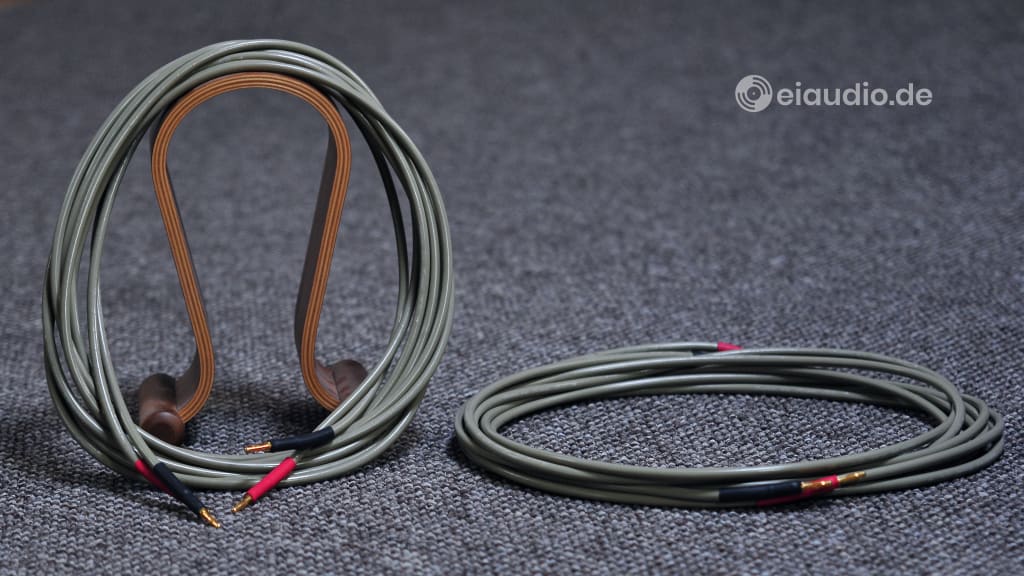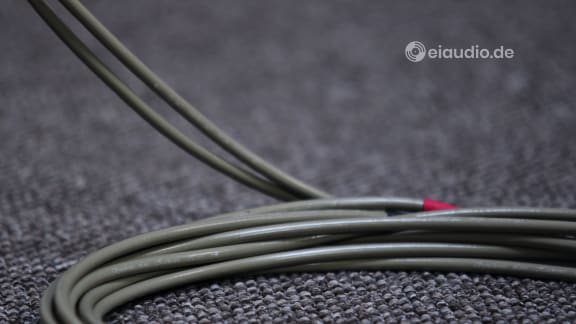Symphonic Line Harmonie HD
Published: 09/06/2024
Manufacturing date: 2023
Author: Karsten Hein
Category: Gear & Review
Tag(s): Speaker Cables
“I would not focus on cables so much, as long as you like the sound and they fit your equipment.” Heinz-Peter said to me over the telephone the other day. — This was not the response I had been hoping for, considering that I had just completed my review of MIT’s “Terminator 5” speaker cables and was diligently working on my articles on Symphonic Line’s “Harmonie HD” and Marc Levinson’s “HF10C”. On the other hand, I knew that HP was right in suggesting that we always listen to a system and rarely to an individual component. This makes cable discussions rather futile and has led to many misunderstandings between audiophiles. Despite all this, even the most sceptical listeners will agree that cables can make or break a great system, and I therefore do believe that they deserve to be discussed in terms of the contributions they make, even if these observations are not finite. After all, how are we to discuss even loudspeakers, if the rooms they are placed in and the HiFi systems that are driving them are not identical?
It is probably fair to say that Symphonic Line speaker cables are primarily designed to work with Symphonic Line equipment. This is especially so, because Rolf Gemein produces HiFi components reaching from power cables via tuners and CD players all the way to the speakers themselves. However, this is not to say that his speaker cables will not work with HiFi gear from other manufacturers as well. In fact, most of my audiophile friends compile their systems with components from many manufacturers and tend to own multiple devices of each product category for system matching and fine tuning. Therefore, this absolute trust in a single HiFi manufacturer to deliver all the components of a system—and this is what it would require if we were to place components matching in the hands of a producer—must be rare. It is also true that some manufacturers only have a single HiFi component of true High End quality in their product portfolio. In this case, the matching of devices across brands becomes a necessity rather than a matter of choice.
It is probably fair to say that we learn most about the characteristics of one HiFi component by successively pairing it up with components from a wide range of manufacturers. The sound signature that is derived from the various combinations serves to reveal the special contribution this component makes to sound: It is the one constant that remains when everything else around changes. Components become familiar individuals, similar to a friendship that becomes deeper and more multi-dimensional as it matures over time. Perhaps it was this perspective that allowed me not to be deterred by HP’s cautious advice and to let myself be guided by the continued urge of exploration that comes so naturally to me and has long since been the basis of this blog.
I set out to test the Harmonie HD speaker cables on my most modern-sounding HiFi setup. This consisted of Tannoy XT8f Dual-Concentric loudspeakers, a brand new Symphonic Line RG 11 MK5 S power amplifier, with upgraded S-transformer, and my recently refurbished Restek V1 preamplifier with fresh caps and improved ops, as well as a custom-built external power supply by Hermann Kassel. My music sources were a Sansui SR 525 turntable, with AT VM540 ML cartridge, and a Denon DCD 1420 CD drive connected to a Cambridge DAC Magic. While this front end did not consist of the highest flying components in the business, both the Sansui turntable and the Cambridge DAC are solid and musical performers that leave very little to complain about. And—important for our gear comparisons—this was the exact same setup that I had previously used on my review of MIT’s “Terminator 5” speaker cables.
Whereas the MITs use a mono-cable design to unite the positive and the negative wires under a single (and quite thick) cable sheath, the Harmonie HD take the opposite approach. Each wire not only uses a separate Teflon dielectric but is also individually wrapped. Although these cables are flexible enough to be rolled up on a large spool, they do not like being bent into small loops and, due to their weight, naturally assume a flat position on the floor. Each cable has an indicator to show the signal direction, and HP informed me that the cable marked red should be connected with the arrow pointing towards the speakers whereas the arrow on the cable marked black should point in the opposite direction. This way of connecting speakers was new to me, and without these instructions, I probably would have connected the black wire’s arrow pointing in the same direction as that of the red wire. My specimens were terminated using Stäubli’s famous Multi-Contact plugs.
When it comes to the terminations, I would have preferred the reduced mass and superior contact of hollow bananas myself and could also feel the slight wobbliness of the plugs in the sockets. However, I decided to forget about this phenomenon, until I had a chance to properly listen to the cables. The music material I chose was varied: Helge Lien’s album “Hello Troll” on vinyl; the German Stereo magazine’s sampler “Die Hörtest CD Vol: IX”, Nick Cave’s live solo concert “Idiot Prayer”, and Laura Kipp’s 2023 album “Sunset Balcony” on compact disc.
Compared with the MIT “Terminator 5” cables, the difference in sound was enormous. The Symphonic Line cables sounded quite a bit louder. Whereas the MIT had given preference to bass punch and a dark setting to the music, the Harmonie HD cables appeared dynamically capable and fast across the frequency band. I noticed a perplexing increase in fine dynamics and detail, which the MITs had previously hidden. Sound was at once highly energetic, engaging, and entertaining. The midrange compression of the Terminator cables was gone, and vocals sounded sweeter and highly believable. The stage impression was natural, although the spaces between the instruments appeared a little fuller than would have been perfect. The amount of detail and attack seemed quite overwhelming. Especially the “Hörtest CD Vol: IX” produced a consecutive chain of musical highlights, up to the point where I started to wonder, if I would actually be able to listen to music of this intensity over a longer period of time. Permanent crescendo and vast amounts of detail might be impressive at first, but they are not very realistic.
“A highlight is the special moment in which the music rises above itself” my HiFi chum Luigi used to say. And, for a moment, I could appreciate what he meant by it. I therefore decided to exchange the Restek V1 preamp with the Symphonic Line RG9, still feeding into the RG 11 MK5 S power amplifier. As I sat down to listen, I was happy to observe that the overly eager presentation of the Restek had been replaced by calm sophistication. Although the music was still detailed and dynamic, the vocals were even sweeter. New spaces had formed between the individual instruments, both dimensionally and—as Symphonic Line does so well—tonally. Tonal separation and accuracy might just be the most perplexing and alluring aspect of listening to music. Superb transients and realistically long decay made for a highly musical listening experience.
My personal listening preference is for Jazz combos, singer-songwriter, and Folk music. This is possibly so, because I enjoy the recognisable instrumentation, the natural order, and the hand-made simplicity of it. All the more, I was surprised by how well the Harmonie HD managed to maintain these dimensions in Eduard Strauss’ fully orchestrated title “Bahn frei Polka”, and they did so without sacrificing detail and speed. Scotty Wright’s rendition of “Sound of Silence” includes a slight touch of harshness in the vocal recording, which became less pronounced with the RG9 as preamp but was still audible. In “New June”, Tokunbo’s voice was sweet and alluring, while freely levitating over a seamless carpet of puckering bass. Nick Cave’s impressive pandemic-year solo performance of “Idiot Prayer” at London’s Alexandra Palace revealed a youthful, boyish charm in his voice that took me by surprise. I was quite familiar with the album, and remembered his voice to be older.
Listening to this setup made me want to browse through my music selection once again to see what else I had missed in the recordings. Symphonic Line cables are relatively insensitive to distortion when touching and crossing themselves and other cables. However, I have found that they, too, benefit from a faultless installation, if they are to provide undisturbed transductance, which translates into tonal and spacial correctness, and fully intact micro-dynamics. The Harmonie HD is a fast and revealing loudspeaker cable that is capable of pairing a balanced tonality with dynamics and detail. Its agility and clarity make it unforgiving of faults in the system, particularly near the music source. Depending on your taste in music and your knowledge of how to properly set up your HiFi system, you might find this either be a true blessing or a curse. Either way, it is going to make its mark on your system.
Specifications
- Type: single-wiring loudspeaker cable
- Features: fully shielded, directional
- Length(s) tested: (2x) 4.00 meters
- Termination: Stäubli Multi-Contact
- Weight: 2,058 g (per stereo pair)
- Country of manufacture: Germany
- Year(s): 1994 - today




